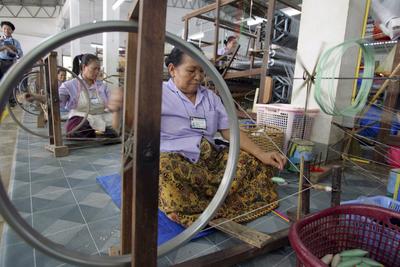An alarming 89 per cent of respondents agreed with the statement that ‘Government policies to admit migrants should be more restrictive’, while only 40 per cent believed that migrant workers make a net contribution to the economy. The results echo previous findings from another ILO/UN Women-commissioned study conducted by Assumption University in late 2006, which found that most respondents believed that migrant workers should not be able to apply for any job, and that Thailand did not need migrant workers to sustain its manufacturing and agricultural industries.
The negative attitudes revealed by that survey were fuelled by concerns over the sharp increase in the number of migrant workers, which nearly doubled from 2004 to 2007. As of 2007, immigrants represented around 5 per cent of the country’s workforce of 36 million. Most migrant workers in Thailand come from the Greater Mekong sub-region; approximately 75 per cent come from Myanmar and 12 per cent each from Cambodia and the Lao People’s Democratic Republic. These immigrants are largely young and low-skilled, and around three-quarters are unregistered or undocumented.
The fact that an increasing number of migrant workers — documented or undocumented — are demanded in key industries such as agriculture, fisheries and construction indicates that these industries now depend on foreign labour. Clearly, restricting migrant workers’ ability to work in these industries would adversely affect the Thai economy. Recent estimates by Martin and Pholphirul suggest that the contribution of migrant workers to Thailand’s real GDP is approximately 1 per cent per annum. Given that migrant workers constitute 5 per cent of the country’s total workforce, their disproportionately low contribution to GDP reflects their lopsided presence in low-productivity industries.
The Thai economy is characterised by the coexistence of a capital-intensive formal sector and a large labour-intensive informal sector which employs mostly low-skilled and temporary workers. Employers in this sector usually offer lower wages without benefits or job security to their workers. The Thai labour force’s rapidly increasing education levels mean that younger Thais are now turning away from informal so-called ‘3D’ (dirty, dangerous and demeaning) jobs. This growing void has been filled by incoming foreign workers, the majority of whom have attained less than a lower primary education.
Greater inward migration over the three-year period from 2004 to 2007 caused only minor adverse effects on the least-skilled local workers’ job opportunities. Even in the presence of a large number of migrant workers, the Thai labour market continued to tighten and the unemployment rate for the least-skilled workers declined further over the following three years to 0.35 per cent in 2010. The aggregate unemployment rate was also at a very low level, at roughly 1 per cent. A tightening labour market at the low end of the skill distribution is also evident in the large increases of hourly wages for workers at the bottom end of the wage percentile which were observed over the period from 2007 to 2010. It is clear that the availability of migrant workers is buying firms in the less-productive industries more time to adopt labour-saving technologies or to relocate if required.
Consistent with previous studies, there appears in fact to be a small negative impact of 0.69 per cent on local workers’ average wages, the wages of those who have at most a primary education. The wage effect of new migrants on existing migrant workers is larger by comparison, at roughly negative 2 per cent. Due to their complementarity in production, the inflows of low-skilled immigrants are found to raise the productivity and hence average hourly wages of native workers with a high school or college education by 0.56 per cent and 0.57 per cent, respectively. Due to the larger share of high school- and college-educated workers in the Thai labour force, and the higher wages commanded relative to the less-educated groups, it is clear that there is a net gain in the wages of local workers from immigration. The positive effects on the wages of skilled workers (high school and college graduates) outweigh the negative effects on the wages of native low-skilled workers.
Dilaka Lathapipat is a recent PhD graduate in economics at the Australian National University, and is now Research Specialist at the Thailand Development Research Institute, Bangkok.
This article appeared in the most recent edition of the East Asia Forum Quarterly, ‘Where is Thailand Headed?’.

